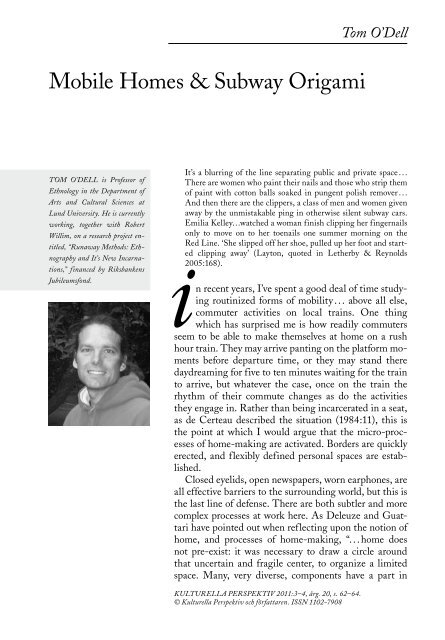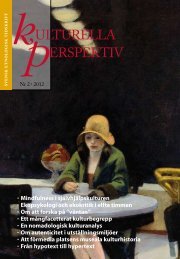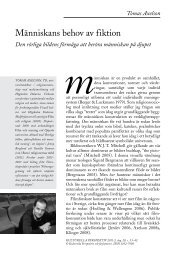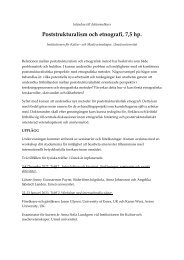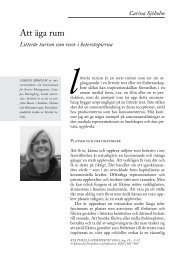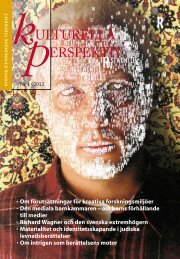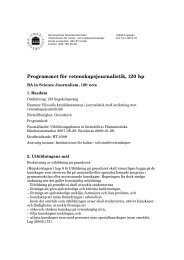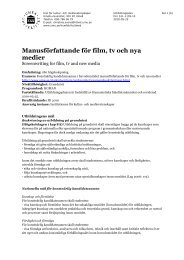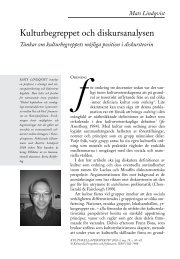Läs hela nr. 3-4 här - Institutionen för kultur och medievetenskaper
Läs hela nr. 3-4 här - Institutionen för kultur och medievetenskaper
Läs hela nr. 3-4 här - Institutionen för kultur och medievetenskaper
Create successful ePaper yourself
Turn your PDF publications into a flip-book with our unique Google optimized e-Paper software.
Tom O’Dell<br />
Mobile Homes & Subway Origami<br />
Tom O’Dell is Professor of<br />
Ethnology in the Department of<br />
Arts and Cultural Sciences at<br />
Lund University. He is currently<br />
working, together with Robert<br />
Willim, on a research project entitled,<br />
“Runaway Methods: Ethnography<br />
and It’s New Incarnations,”<br />
financed by Riksbankens<br />
Jubileumsfond.<br />
It’s a blurring of the line separating public and private space ...<br />
There are women who paint their nails and those who strip them<br />
of paint with cotton balls soaked in pungent polish remover ...<br />
And then there are the clippers, a class of men and women given<br />
away by the unmistakable ping in otherwise silent subway cars.<br />
Emilia Kelley…watched a woman finish clipping her fingernails<br />
only to move on to her toenails one summer morning on the<br />
Red Line. ‘She slipped off her shoe, pulled up her foot and started<br />
clipping away’ (Layton, quoted in Letherby & Reynolds<br />
i2005:168).<br />
n recent years, I’ve spent a good deal of time studying<br />
routinized forms of mobility ... above all else,<br />
commuter activities on local trains. One thing<br />
which has surprised me is how readily commuters<br />
seem to be able to make themselves at home on a rush<br />
hour train. They may arrive panting on the platform moments<br />
before departure time, or they may stand there<br />
daydreaming for five to ten minutes waiting for the train<br />
to arrive, but whatever the case, once on the train the<br />
rhythm of their commute changes as do the activities<br />
they engage in. Rather than being incarcerated in a seat,<br />
as de Certeau described the situation (1984:11), this is<br />
the point at which I would argue that the micro-processes<br />
of home-making are activated. Borders are quickly<br />
erected, and flexibly defined personal spaces are established.<br />
Closed eyelids, open newspapers, worn earphones, are<br />
all effective barriers to the surrounding world, but this is<br />
the last line of defense. There are both subtler and more<br />
complex processes at work here. As Deleuze and Guattari<br />
have pointed out when reflecting upon the notion of<br />
home, and processes of home-making, “. .. home does<br />
not pre-exist: it was necessary to draw a circle around<br />
that uncertain and fragile center, to organize a limited<br />
space. Many, very diverse, components have a part in<br />
KULTURELLA PERSPEKTIV 2011:3–4, årg. 20, s. 62–64.<br />
© Kulturella Perspektiv <strong>och</strong> <strong>för</strong>fattaren. ISSN 1102-7908


